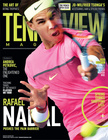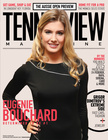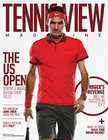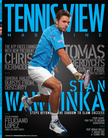Don't miss any stories → Follow Tennis View
FollowRecap: 2025 World Tennis Conference
The fifth World Tennis Conference March 27-30, 2025. Dream Big. Coach Better!
The World Tennis Conference continues its mission to bridge the gap between the game’s elite coaches and the global coaching community. Hosted by the Segal Institute and GPTCA, with the support of the ATP and powered by coachtube, this four-day virtual, high-performance tennis conference has assembled ninety-two experts including renowned scientists, iconic tennis figures, industry leaders, and the world’s most distinguished and respected coaches.
For a reasonable fee, participants will have access to seventy online presentations and interactive workshops available for repeated viewing. For the fifth consecutive year, the WTC facilitates the dissemination of knowledge and experience so that coaches may transform and augment their coaching to elevate players to the pinnacle of the sport. The WTC encourages coaches to invest in themselves throughout their journey.
Liam Smith: How Tennis Analytics can help as a competitive coach
Strategic coaching at the elite level. A national head coach for Tennis Australia and former coach of Gael Monfils. There are many types of strategic coaching and they should be assessed based on long-term development objectives. Strategies include surface-specific, game-style-specific, opponent specific. It’s paramount to build and protect a player’s confidence so from a strategic standpoint, if they struggle on clay, don’t schedule too many events on that surface. Communicate with your player; share what you observe with what they experience. Keep things simple. Don’t overload your player with information; strategize it! By utilizing analytics, coaches can give players the best opportunity to win. Was it the wrong tactic or poor execution? The difference must be discussed. The primary goal is for the player to execute with great clarity and composure. Prepare in detail and communicate with simplicity. Know your player and how they best process information. What matters most is what they hear and understand. What you say, may not be what they hear and comprehend. For more information, visit www. lcstennis.com
Claudio Pistolesi: The relation between on/off court of the player behavior and attitudes
JTCC Florida Director and former coach of Robin Soderling, Daniela Huntuchova, and Takao Suzuki. Learning is perpetual. Coaches must observe player’s off-court lifestyle and how it impacts on-court behavior. Coaching is a 24-hour mission. Coaches must structure daily routines to create self-discipline and tailor coaching to support their habits. Traits of a long, fruitful career - look to Novak Djokovic. He’s continually tweaking his nutrition, sleep, and stretch routines. Coaches must remain students of the game to keep improving and prolong careers. Biggest off-court mistakes: taking things for granted with no accountability from the player. Consistency in training, recovery, and nutrition is crucial for success. Results influence behavior, especially losses. Habits lead to predictability so the same routine whether you win or lose. Discipline remains constant and this produces champions. Social media must be managed. It can be beneficial to players but also extremely harmful. It enables direct communication with fans but opens the door to bullying and threats. The best way to recover from a tough loss is to identify the primary reason; was the player distracted or too emotional? Did attention shift to the result instead of the competition? Body language and self-talk after errors cannot be underestimated. Coaches must always be prepared and detail-oriented. Players expect a great deal from themselves and their coach. Young coaches should monitor, study, and observe their players on and off the court. Learn and sync their on and off-court habits. For more information, visit www. claudiopistolesitennis.com and purchase C’era Una Volta Il (mio) Tennis.
Kristof Vliegan: My views to create effective training systems
Belgian and former top 30 player who currently coaches world #51, Zizou Bergs. He created a development plan for a promising young Dutch player, Tallon Griekspoor (now twenty-eight) who reached a career-high of #21. Key principles: the player is open-minded, wants to improve, and is aggressive. The player adjusts throughout the match even when winning. Build game when they are juniors. It’s vital to amass confidence especially when new on tour. Tactics are crucial; look for the opponent’s weaknesses and expose them. Learn how to construct points. Never hit a defensive shot in the net or wide; must get defensive shots in play. Play with your strengths and maximize them. You cannot run from pressure; use it to your advantage and view it as an ally, not an enemy. Player/coach have different expectations. The best expectation is to try your best every day. The opponent is always part of the equation and the best player that day doesn’t always win. Players must always look for solutions and be aware of momentum and how/when it shifts. The player and coach must spend time apart to keep the relationship fresh. Even if a player loses a point, he’ll applaud provided they executed the game plan. If the player doesn’t want to talk back. It’s important to know what the player felt during the match – not just what you observed as the coach. Coaches are facilitators helping players win matches and learn from losses. Players must trust the coach – if not it’s a waste of time. With juniors, training must be geared towards their level in five years. Coaching is typically a 5-10 year commitment so with young players it's essential to build that base during the first two years. For more information, visit www. unboxsports.com
Sascha Bajin: My coaching philosophy applied to high-performance tennis players
Former coach of Naomi Osaka, and former sparring partner and coach of Serena Williams. In 2018, named WTA coach of the year. Currently coaching #20, Donna Vekic. Specialist in mental training and strategic development of high-performance tennis players. Core principles: it’s not about the coach – it’s always about the player. How can you help the player facilitate the achievement of their goals? Assist in making off-court life joyful and devoid of stress. This is underrated and essential for the player to compete at an optimal level. Coaches must practice what they preach and be a positive, inspiring role model. He leads by example by eating well, staying fit, and getting adequate rest. Short-term goals help achieve long-term goals. Transition from juniors to pros: must train the brain. Junior players must understand that as a pro, your days/nights are structured to facilitate success. During practice, it’s imperative to put players in uncomfortable positions. Have them practice with players they don’t like; this creates pressure and compels the player to become comfortable with the uncomfortable. He sees himself as a leader – not a boss. It’s always “we” and “us.” Consistency separates the top players from the pack with their unwavering drive to win and unmatched discipline regarding nutrition, sleep, and fitness. Focus on the glass ½ full as opposed to ½ empty. It’s how one states it that matters and consequently, how it’s received by the player. He is not in favor of on-court coaching yet it serves to highlight its importance. When to speak is significant and typically less is more. It doesn’t matter how much one knows if it isn’t clearly communicated. Look for that bridge, close the gap and great things will happen. In one year, he took Osaka from #70 to #1! For inquiries email: Bigsascha18@hotmail.com
Pierre Lamarche: Ensuring your player has the proper skills required or first step on tour
Former player and distinguished coach from Canada. In 1976 in Burlington, Ontario, he founded ACE Tennis Academy which produced top-level players. He developed an integrated player management system. Similar to Italy which transitioned away from national centers, they focused on regional development of players. They filled a void by creating a new system that empowers coaches to develop players from the age of 5 to 15 - the ACE System. It’s an approach that maximizes the long-term development and performance of players in this age category. It’s succeeded as a result of “sixty years of experience, research, and mentorship from recognized coaching innovators.” It addresses the development of the future player systematically through progressive tennis. What will the player of the future look like and which skills are requisite for success? By the age of fifteen, no technical glitches and tactics well-ingrained. The player of the future is a supreme athlete with exceptional speed, agility, and endurance with a focus on injury prevention and recovery. They possess enhanced shot variety, mental resilience, and through the utilization of AI, tactical and strategic advantage. Not concerned with agents who are primarily driven by money. ACE asserts that if you develop the player, the money will follow. For more information, visit www. acsminc.ca and pierre@acetennis.ca
Nicole Pratt: Considerations on coaching women and girls in your program and competition
She has been coaching women’s tennis for the last fifteen years and was a top forty player from Australia. It’s extremely important when working with a new player to develop the relationship. To have a successful partnership, there must be trust, respect, and a productive communication framework off and on the court. More time is spent off-court than on. If the player knows you care, they will trust you and this is vital. Goals must be aligned and the coach must create a culture of belief since females tend to be self-critical. Develop them to have limitless tactical options so they can problem solve. Have a female mentor on the team and do your homework since women are inquisitive. Encourage and support players competing in doubles – great skills are acquired while friendships are forged. Data is helpful because it’s devoid of emotion. Women are different than men so coach accordingly. Don’t call women girls! Language has consequences. Don’t assume that something is understood because you explained it once. Don’t underestimate the effect of puberty and the toll it can take on young girls. Forehands are dominating the game, especially the shot after the return, primarily on hardcourts so coaches need to develop it. Effects of menstruation should not be minimized while upper body strength should be maximized. Good nutrition is vital for building and maintaining lean muscle and this should be monitored in conjunction with the physical performance coach. In addition, be attentive to low energy and motivation, low bone density, and painful periods. For more information, visit @nicole_pratt_oly and @unboxsports
Hunter Reese: Doubles coaching concepts and new projects
Player and coach. NCAA doubles champion and ATP tour player for ten years. Currently coaching the doubles team of Evan King and Christian Harrison who are 5th in the race to the Nitto ATP Doubles Championships. Coach/player relationship is ever evolving. Coaches must develop the player to their potential and when the player buys in – results follow. What does my player need from me? Scouting? Data analytics? Coaches must be receptive to feedback and criticism, build trust, and maintain open communication. They need to recognize when to back off and when to push. Know your player as a competitor and human being. Constructive feedback is important. It’s always easier to play as the underdog so as they progress, learn to manage the pressure of expectation. Incorporate pressure into practice sessions by having them compete against higher and lower-ranked players. He is also a player ambassador of Intennse - a new format of tennis as well as pathway. It’s team-based with plans to expand across the country and eventually the globe. It involves pros, juniors, and college showcases with prize money and is currently operating in Tampa, Jacksonville, and Atlanta. Intennse is a time-based format typically lasting two hours with free fan movement. It’s an immersive experience where players interact with fans both onsite and online. It’s a great training tool that would translate well at the academy level. Since points are played at rapid succession, it would help juniors develop “amnesia” after losing points. A coach must be a lifelong student of the game and continue to evolve in tandem with the sport. Never think you have it figured out; remain curious and continue to improve. For my information, visit @volreese and www. intennse.com
Gonzalo Lopez: The roadmap to be an ATP/WTA coach
Former ATP player who coached several ATP players. Motivation changes with age so dream big and craft a plan to achieve it. He was fortunate that as a player, he had connections. To succeed, put yourself in the right environment. Coach competitive players regardless of level. Be ready to commit to the player and travel with no weekends or holidays off. All your time belongs to the player so you must be free. Many different environments in which to coach; a country club, tennis club, tennis school, academy, or an official structure like a federation. Academies are great places to start coaching but you must remain 4-6 years so people come to know you. There you can develop players but must be responsible, trustworthy, and drama-free. To be a freelance coach, you need experience and the ability to manage pressure. When you are a young coach, it is difficult to become known on the ATP tour. In 2010 -2014 he rented space and established an academy. In 2015 he started a smaller academy in Barcelona. By keeping it small, players receive more attention. The player competing at a 12 and under event views a match just as seriously as an adult competing at the French Open. Young coaches should travel to events and meet other coaches. Talk, learn, and be open. Create your own philosophy and paradigm. Coaches must be competent in many areas. Keep learning – not just about coaching but new technologies, marketing, finances, and social media. Work for yourself even if employed by an academy or club – it’s your reputation/work that will be judged/remembered so don’t create problems! Always treat people well; plant seeds of well-done jobs and you will be remembered and recruited! For more information, visit www. glopez.es
Lorenzo Beltrame: From hitters to players. From teachers to coaches
Top WTA/ATP coach who worked with Pete Sampras and Jim Courier. He developed high-performance programs and is an expert in mental fortitude and training, applying the methods of Dr. Jim Loehr across various sports and led the Mental Toughness Certification Program for coaches. As the president of Lorenzo Beltrame Performance Solutions, he strives to develop the mentality required to go from hitter to player, from teacher to coach. Must take care of the person, and their well-being for part of the person becomes the player. A “hitter” is the executor of the game while the “thinker” strives/adjusts to play the game. Create intentions for every match and practice. Self-affirmation builds confidence and sustains it. The coach must spend time off-court with the player and provide tools to learn and grow. The “fan” is the inner voice that keeps one accountable but in a constructive way. If a player derides themselves off-court, it will manifest negatively on-court. Most coaches focus their attention on technique, tactics, and strategy. To transform the player into a “thinker” and “fan” and take them to the highest level requires a coach who not only teaches technique but is a mentor of communication. The coach of the future is a holistic coach – first a human being then a tennis player. Coaches need to be mentored by other coaches; seek their advice and learn from their experiences. The journey of the player encompasses their personal development; all the failures and challenges related to the sport contribute to the development of a resilient, more functional human being. Motivate players and provide tools to effectively manage emotions. Continue explaining until the player understands that coaches are in service of others. Time invested by a coach is tremendous and requires stamina and resilience. Coaches should be energetic, passionate, and kind. Put player at ease but challenge when necessary. Talent isn’t enough to become a great coach or player. Coaches must continually improve and expand their competencies. Meet other coaches and attend conferences when able. Always remain curious and invest in knowledge. For more information, visit www. lbperformancesolutions.com
Ted Sichelman: master the return of serve.
Founder of Golden Set Analytics – a leading company in analytics for the top players on the ATP and WTA tours. Assembled a massive database of 35,000 matches to discern micro-level data. It’s a very sophisticated predictive model that if utilized properly, will enable players to improve their overall winning percentage against specific opponents. The data affirms that the return of serve is a critical shot. Many of the top-ranked players are the top returners on tour. Iga Swiatek and Coco Gauff, world #2 and 3, win 48% of return points. Most points include a return unless an ace or double fault. Since most points on hardcourts end within four shots, the return of serve is crucial. Hit return down the middle or into the corners? Hug the baseline, step inside, or 3-6 meters behind? The data reveals the following: on the ATP tour with right-handed players ranked in the top 25 receiving second serves on the deuce side, staying very close to the baseline has the lowest winning percentage. When receiving on the ad side, the data is similar: standing 2-4 meters behind the baseline is the most effective. If they return up the middle from the deuce side, the server wins the point 58% of the time. Returning from the ad side, going crosscourt is most effective. Since serve speed is considerably slower, the data differs on the WTA tour and for juniors. As the serve slows down, players will move closer or inside the baseline to return and were most successful returning from the deuce side. It was more effective to move back when returning from the ad side especially when facing a kick serve out wide. This data was similar for junior players both boys and girls aged 14-18. Contrary to popular belief, going down the middle when returning second serves is the least effective so go for the corners! The more you practice and hit the corners, the more you will hit winning returns. For more information, visit www. goldensetanalytics.com
Murphy Jensen: How we connect with our internal human project
1993 French Open doubles champion with his brother Luke. Coached Serena and Venus Williams in World Team Tennis and is the Co-founder of WEConnect. This online app aids those in recovery from addiction. He is in long-term recovery from mental health challenges and substance use disorder. His challenging journey led him to his current role helping those suffering from mental health conditions. In 1993 after triumphing at the French Open, he experienced his first panic attack. For six years he battled mental health disorders despite appearing happy and accomplished. In 1999 after the birth of his first child while competing at the US Open, he contemplated suicide and was admitted to a psych ward and detox. Today as the co-founder of WEConnect Health Management a mobile application innovation, one million people from thirty countries have been assisted. They address fear, anxiety, depression, and loneliness – conditions experienced by many professional tennis players. The greatest tool a coach possesses is his/her experience. As a coach, it’s hard to transmit something you have never experienced, therefore, what he endured, he shares. Coaches need to be in service of their players and help them become better human beings. Unreasonable fears, doubts, and insecurities chased him his entire life. He repeatedly self-sabotaged so the key was altering his perspective. I may be the problem but I’m also the solution! As coaches, it’s imperative to work on mental fortitude and agility. You gain confidence through the preparation and work but it’s the trust between player and coach that is non-negotiable. Issues surrounding mental health are preventable and treatable. Once you surrender to it, you will be free. He’s successfully leveraged his “mess” to help others, especially within the tennis community. Embrace the good, bad, and ugly and bring love to your work for in tennis, love wins. He learned more from his losses and setbacks than wins. Something negative provides an opportunity for growth and this is the Murphy mantra! For more information, visit www. weconnecthealth.io
Marie France Mercier & Alastair Millar: The art of coaching in the world of AI. Director and consultant for performance coach Education & Services Tennis Canada
With a myriad of technological innovations, the landscape of coaching continues to transform at an unprecedented rate. At Tennis Canada, AI has been integrated into development programs and in so doing, has leveraged cutting-edge technology to enhance coach education, player analysis, and performance tracking which perfectly aligns with their holistic person-first approach. Coaches and players at all levels now have an opportunity to embrace these tools to further their development. From video analysis and Hawk-Eye to wearable devices and VR, biofeedback tools and mindfulness apps have become crucial in managing on-court pressure and mental resilience. Coaches must stay ahead of the science to best assist their players. AI is one tool among many at the coach’s disposal. Coaches must be able to accurately interpret and integrate AI to best affect their player’s performance. AI, however, is not without constraints. It doesn’t commit to the player; endure the inevitable ups and downs. The best coaching happens during tough moments. AI cannot ignite passion and perseverance. Is coaching an art or science? It is both and often intertwined. Which data should be utilized? If the player does not trust the coach, they will not buy into the technology. Consequently, the interpersonal and communication skills of the coach remain paramount. AI complements the human connection at the heart of coaching. Like players, coaches are developed holistically. The best don’t resist AI they utilize it to enhance their coaching. AI tools are undeniably powerful and are most effective when combined with human expertise. AI is a supplement not a substitute for high-quality coaching. Coaching excellence entails balancing science with intuition, structure with adaptability, and data with a human touch guiding each player toward their unique potential. For more information, visit mfmercier@tenniscanada.com and amillar_external@tenniscanada.com
Fernando Segal: Training the heart of the player. Tips using the 4 tennis concepts
He is the founder and CEO of the Segal Institute, GPTCA President for Argentina, Chile, and Mexico, and the Creator & Director of the World Tennis Conference.
Coaches correct technique and footwork but ignore the level of passion and effort put forth by their players. Must play every point with heart and this can be trained. With every drill, the coach must develop an intention and emotional connection. Personal commitment and resilience fuel greatness. Champions have heart; they are driven by passion, purpose, and effort. Coaches are facilitators and consultants who guide players to be the best version of themselves. Play with purpose and those who understand their “why” remain motivated. If you are not giving your all, you are not giving anything! How much are you going to give me? What price are you willing to pay? Intrinsic motivation is the key to sustained improvement. Effort is a personal resource and like footwork, a skill that can be trained. Mental toughness must be developed to sustain effort. Small daily efforts accumulate into major improvements. Push beyond your limits like Andy Murray following hip surgery and maintain a positive mindset to endure injuries and losses. Accept that failure will help you to grow and learn to appreciate the journey; love the process not the result. Tennis is a very unpredictable sport. It unfolds in real time so players must adapt as variables change. Champions always play with heart even when losing. Utilize drills to work on the heart of a champion. Players must exhibit the same level of heart, effort, passion, and commitment when placed in uncomfortable situations like training at 6 am instead of noon. Over time this will yield mental resilience and adaptability. Be tenacious, show your competitiveness, and reveal your character to your opponent. It’s imperative to maintain a positive attitude and exhibit confident body language. At the end of practice ask your player “Where did you show heart? When did you want to quit but didn’t? Which area of your game requires more heart?” If a player possesses self-awareness, they will be able to identify areas to improve and articulate a development plan. This enables the player and coach to keep progressing and ascend to the next level while embodying love for the game. Coaches like players must work daily with their hearts for they are in service of the player. Learning is perpetual so never stop investing in yourself! For more information, please connect with Fernando@segalinstitute.org www. worldtennisconference.org and wtc5.coachtube. com.










